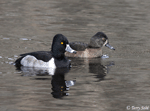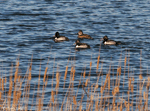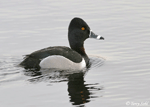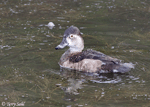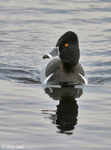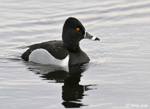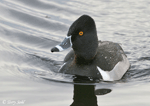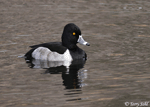| Length: 15-18 Inches | Wingspan: 25-30 Inches | Seasonality: Migrant/Summer |
| ID Keys: (male) Black and white rings on bill, black head and back, white bar separating gray sides and black chest. Chestnut-colored ring on neck is usually quite difficult to see. | ||
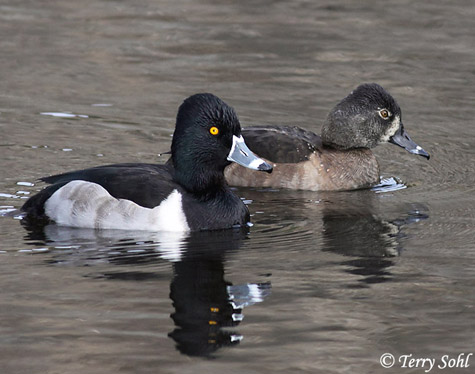 Despite the name, the brownish ring on it's neck is rarely visible in the field.
The more obvious field mark is the unique bill coloring, showing a dark black
tip, and obvious white stripes on either side of a bluish-gray base color. Ring-necked Ducks are a diving duck that migrate through the state, summering only in the northeastern part of the
state. As with most ducks, male and female plumage is dramatically
different (see photo of male and female to the right).
Despite the name, the brownish ring on it's neck is rarely visible in the field.
The more obvious field mark is the unique bill coloring, showing a dark black
tip, and obvious white stripes on either side of a bluish-gray base color. Ring-necked Ducks are a diving duck that migrate through the state, summering only in the northeastern part of the
state. As with most ducks, male and female plumage is dramatically
different (see photo of male and female to the right).
Habitat: Lakes, ponds, sloughs, and marshes
Diet: Primarily aquatic plants. Also aquatic insects, crustaceans, and mollusks.
Behavior: Diving duck, normally feeding by diving in relatively shallow water, although they will also occasionally feed similarly to dabbling ducks. Female ducks will stay with fledglings an unusually long time compared to most ducks.
Nesting: June and July nester. The nest of a Ring-necked Duck is vegetation lined with down, placed near the water's edge amidst cover vegetation. The female lays between 6-13 eggs, and she alone incubates them. The eggs hatch after about 4 weeks.
Song: Ring-necked Duck Song
Migration: Summers through Canada, the upper Midwest and Plains, and New England. Winters in the Southern U.S., along the coasts, and in Mexico.
Interactive eBird Map: Click here to access an interactive eBird map of Ring-necked Duck sightings
Similar Species: Lesser Scaup, Greater Scaup. These species share somewhat similar overall plumage patterns, with light flanks and dark breasts and head. The obvious bill pattern on the Ring-necked Duck makes it easily distinguishable from those species if seen well.
Conservation Status: Populations stable and expanding in parts of the U.S. and Canada. They are common in parts of their range. The IUCN considers the Ring-necked Duck to be a species of "Least Concern".
Further Information: 1) USGS Patuxent Bird Identification InfoCenter, Ring-necked Duck
3) Audubon Guide - Ring-necked Duck
Photo Information: April 5th, 2008 - Dewey Gevik Nature Area near Sioux Falls - Terry Sohl
Additional Photos: Click on the image chips or text links below for additional, higher-resolution Ring-necked Duck photos.
| Click on the range map for a higher-resolution view |
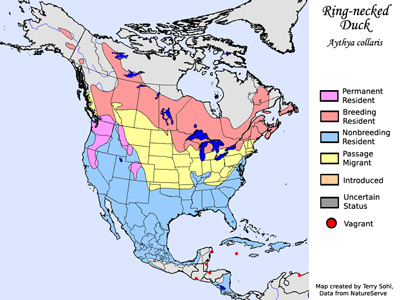 |
| South Dakota Status: Common migrant and summer resident throughout most of the state. Uncommon in winter. |
Additional Ring-necked Duck Photos
Click for a higher-resolution version of these photos
